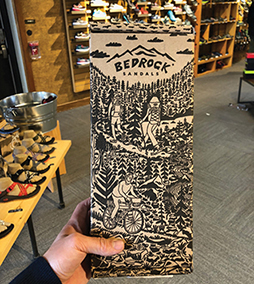In the past decade, sustainable packaging initiatives have grown in popularity, and consumers have come to expect the products they purchase to be packaged in sustainable materials. Several large corporate brands have launched initiatives to produce and/or use only 100% sustainable packaging materials by 2025. These companies are searching for sustainable materials to produce eco-friendly packaging, including printing ink. Globally, packaging ink makes up $8 billion of the overall $20 billion printing ink market.

▲ A brand called Bedrock Sandals sells shoes in REI stores around the U.S. The company exclusively uses black Algae Ink produced by Living Ink Technologies.
Ink is approximately 80% base and 20% pigments. The base can be made of water, petroleum, soy oil, and other solvents. The pigments are made from finite inorganic chemicals and petroleum. For example, carbon black is the pigment used to create black ink. Carbon black is generated by the incomplete combustion of heavy petroleum products. Globally, 14 million tons of carbon black is produced every year, releasing over 35 million tons of CO2; carbon black has been labeled a class 2B carcinogen according to the International Agency for Research on Cancer.
With funding from the National Science Foundation, Living Ink Technologies, a Colorado-based biotechnology startup, is developing safe and renewable pigments from algae. To make black pigment, the company processes byproduct generated by the algae bioproducts industry so that each algal cell encapsulates pigment. No extraction steps are necessary to isolate the pigment — the algal cells themselves can serve as ink. The pigment generated is blacker and more resilient to ultraviolet (UV) light than traditional carbon black. And, the process is carbon negative. For every kg of black pigment produced from algae, 1,681 g of CO2 are sequestered. In contrast, the production of 1 kg of carbon black releases 3,750 g CO2 equivalent.
A hallmark of high-quality ink products is their small pigment particle size. Traditionally, carbon black pigments range from 20 nm to 1 μm. A current product target for Living Ink is the production of flexographic and offset inks. These inks make up a large part of the global ink market and are commonly used for packaging printing. For flexographic and offset ink, the pigment size must be at most 1 μm. One reason Living Ink targeted algae for printing ink is that algae cells are approximately 1 μm in diameter. And, the company has developed downstream processes to reduce particle size to near 300 nm.
Beyond black pigments, Living Ink is using molecular biology strategies to develop novel algal strains that generate a variety of colors. Naturally occurring gene pathways are inserted into the algae cells so the colored pigments are expressed and upregulated. For example, a purple color was generated by inserting the genes that produce a purple molecule called deoxyviolacein. The goal is to produce high-quality cyan, magenta, and yellow (CMY) pigmented cells. Like a color printer, mixing of CMY pigmented cells would produce a wide color palette. To date, scientists at Living Ink have produced several colors and are pursuing more.
In terms of commercialization, Living Ink sells a variety of black ink products to printers. Algae-based inks can help customers increase the percentage of biobased materials in their processes and/or products, and can help them pursue sustainability initiatives such as compostability. To overcome adoption challenges, Living Ink has carefully formulated its Algae Ink product so it can be plugged directly into the supply chain. The ink is used the same as any traditional ink and performs well on standard printers.
Kyle Wente, the president and owner of Ecoenclose, explained, “We are thrilled to be working with Living Ink because it supports our mission to find and develop the most sustainable packaging solutions. Our best customers consider all aspects related to sustainability, including the ink that we use. Therefore, it’s important to us and to our customers that we continue to help drive innovation and expand our offerings for algae-derived inks.”
To start fulfilling on these orders, Living Ink has built a pilot plant that can produce 75,000 lb of ink per year. These ink products will initially target the packaging industry and then move on to other markets such as ink for pens and textiles.
This technology was funded through the NSF Small Business Innovation Research Program.
This article was prepared by the National Science Foundation in partnership with CEP.

Copyright Permissions
Would you like to reuse content from CEP Magazine? It’s easy to request permission to reuse content. Simply click here to connect instantly to licensing services, where you can choose from a list of options regarding how you would like to reuse the desired content and complete the transaction.
